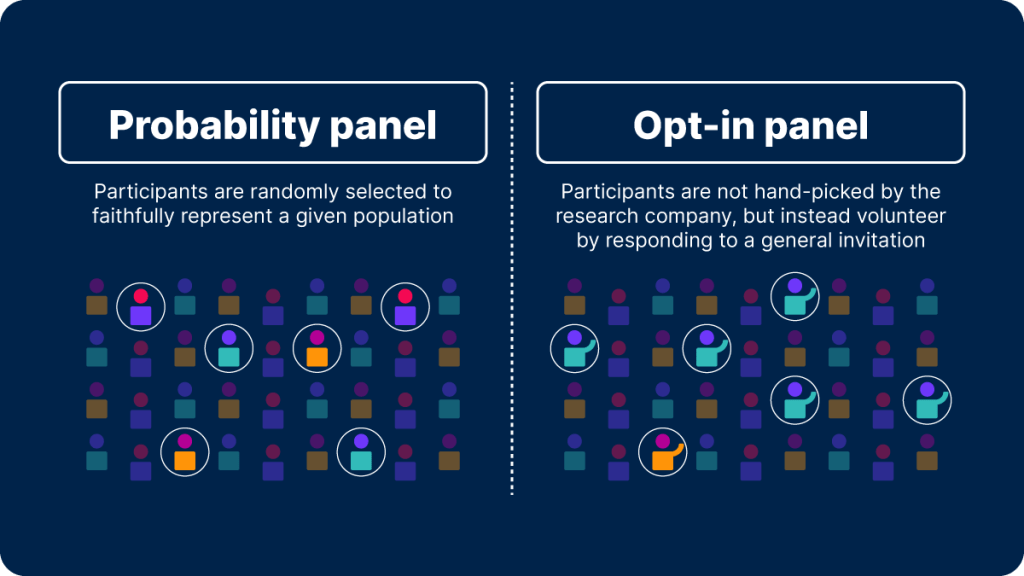Panels—and the data they generate—have been the research industry’s gold standard for nearly a century now, and they remain the most accurate tool to measure media audiences.
Follow along as we break down panel data: What it is, why it’s important and where it’s headed.
What’s a panel, exactly?
In media research, a panel is simply a group of households or individuals who have agreed to share personal details and take part in regular studies or ongoing measurement of their media usage for a set period of time.
But not all panels are the same. There are two major types:

Probability panels
Participants in probability panels are selected to faithfully represent a given population (like a national TV audience or a local radio market). The research company takes great care to manage the recruitment process and maintain the statistical integrity of the panel over time. This means recruiting panelists, registering new devices without delay, accounting for changes in household size and composition, and ensuring the data accurately reflects what people are doing. Nielsen’s TV and audio panels are probability panels.
Opt-in (convenience) panels
Participants in opt-in panels volunteer by responding to a general invitation from a research company. Since only certain types of people might respond to that invitation, opt-in panels aren’t representative of any given population. However, they are extremely useful in audience measurement. They’re helpful in understanding biases in identity, used as calibration inputs to fine-tune models, and can validate and correct third-party information from big data partners. At Nielsen, opt-in panelists aren’t always actively metered, but we do use our large opt-in panel to validate third-party records from big data partners.
Probability panel data, combined with census data that speaks to the income, age and makeup of a household, gives you a statistically accurate look at who is consuming media.
Together, probability and opt-in panels can deliver direct media consumption insights, calibrate and remove biases from census-level data, and ensure the most accurate look at audience engagement across devices.
What are panelists signing up for?
Some panels require active rather than passive participation. Panelists may be asked to fill out regular surveys, press a button to verify that they’re watching TV, or wear a device to capture out-of-home activity like listening to the radio in their car or watching sports at a bar. Other panels don’t require any commitment besides authorizing the research company to install a piece of hardware or software (known as a “meter”) to record their media usage behind-the-scenes: what TV programs they’re watching, for instance, or what podcasts, websites, or apps they’re using.
Active participation, versus automated measurement, is often necessary to capture the most precise person-level data and maximize its value. To keep cooperation high—which is critical to maintaining high data quality—serious research companies invest heavily in the panelist experience to eliminate friction every step of the way.
At Nielsen, we have four different kinds of panels:

• TV — A probability panel that measures the who, what, how and where of TV and streaming audiences
• Audio — A probability panel that measures in-home and out-of-home audio consumption at the local and national level and consists of both metered and diary markets
• Digital — Depending on the market, a metered probability and/or opt-in panel that measures ad and content exposure for computers, mobile and across platforms
• Participant — An opt-in panel of registered, non-metered panelists to enhance our measured panel assets with features like big data calibration and identity validation
How are media panels used?
While panel data may be used by research firms looking for consumer trends or government agencies looking to monitor population consumption habits, media panel data is most often used by media companies, brands and advertisers looking to understand content viewership and advertising campaign reach and frequency.
For networks, publishers and other media sellers, panel data helps them know their audience size, habits and trends, which is then used to inform programming, pricing and content distribution strategies.
For brands, advertisers and other media buyers, panel data is used to understand who’s actually seeing their ads, which platforms their target audiences prefer, and predict how these behaviors may change over time.
Are panels obsolete in the age of big data?
You may be thinking: Do we even need panels now that we have big data from set-top boxes, smart TVs, streaming platforms, social media channels, retail media networks and everything in-between?
That’s a popular misconception.
First off, big data (like automatic content recognition {ACR} data from smart TVs) can tell us what’s playing on screen, but not who is watching, or how many friends and family might be sitting on the couch and watching too. In fact, it’s impossible to tell from big data alone whether a show or a movie is playing to an empty room. Nobody wants to pay for media without an audience.
What’s more, big data isn’t representative of the full media audience. The only way it could be is if everyone used the same technology and had access to the same content available to them. A cable company might have tens of millions of subscribers, but those viewers don’t all pay for the same channels or watch the same programs.
Without the ability to identify real audiences and then pinpoint and represent the demographic profile of viewers, it’s impossible for research companies that rely exclusively on big data to deduplicate audiences across platforms, devices and services—and put the whole story together.
How do you get the best of both worlds?
To be clear, biases that come from sampling or nonresponse issues can cripple a probability panel just as much as a big dataset. But with the right size, the right attention to details and a keen understanding of statistics, a well-run panel is still the best way to represent the general population and provide reliable estimates of audience composition across today’s incredibly diverse media ecosystem.
So, is big data entirely useless? Of course not! Its scale makes it possible to analyze media usage with much granularity, and with the right calibration and people-based modeling in place, big datasets can offer invaluable insights for long-tail programming and hard-to-reach audiences.
A number of organizations, including the World Federation of Advertisers, now believe that the combination of panels and big data is the true future of audience measurement, and many research companies are hard at work developing these capabilities.
Nielsen’s Need to Know reviews the fundamentals of audience measurement and demystifies the media industry’s hottest topics. Read every article here.
Note
1. Two notable early examples were the National Consumer Panel, launched by Samuel Barton in 1942 under Roosevelt’s Office of Price Administration initiative to measure household consumption of rationed goods during WWII; and the panel behind the Nielsen Radio Index, launched that same year by Arthur C. Nielsen to capture radio on/off and channel tuning activity using an ingenious mechanical device first developed at MIT: the Audimeter.



